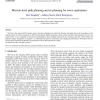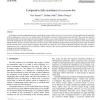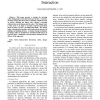RAS
2006
15 years 28 days ago
2006
The Life in the Atacama (LITA) project seeks to develop technologies for robotic life detection and apply them to the investigation of the Atacama Desert. Its field investigation ...
RAS
2006
15 years 28 days ago
2006
This article explores the assumption that a deeper (quantitative) understanding of the information-theoretic implications of sensory-motor coordination can help endow robots not o...
RAS
2006
15 years 28 days ago
2006
In this paper, we study coordinated motion in a swarm robotic system, called a swarm-bot. A swarm-bot is a self-assembling and self-organising artifact, composed of a swarm of s-b...
81
Voted
RAS
2006
15 years 28 days ago
2006
Self-reconfigurable robots are built from modules, which are autonomously able to change the way they are connected. Such a robot can, through this self-reconfiguration process, c...
RAS
2006
15 years 28 days ago
2006
This paper describes an algorithm to calculate near-optimal minimum time trajectories for four wheeled omnidirectional vehicles, which can be used as part of a high-level path pla...
103
click to vote
RAS
2006
15 years 28 days ago
2006
Appearance-based autonomous robot localization has some advantages over landmark-based localization as, for instance, the simplicity of the processes applied to the sensor readings...
RAS
2006
15 years 28 days ago
2006
If we are to achieve natural human
RAS
2006
15 years 28 days ago
2006
86
Voted
RAS
2006
15 years 28 days ago
2006
This paper presents a strategy for ensuring safety during human-robot interaction in real time. A measure of danger during the interaction is explicitly computed, based on factors ...
RAS
2006
15 years 28 days ago
2006
The M-TRAN is a modular robot capable of both three-dimensional self-reconfiguration and whole body locomotion. Introducing regularity in allowed structures reduced difficulties o...



